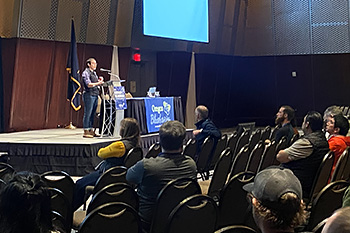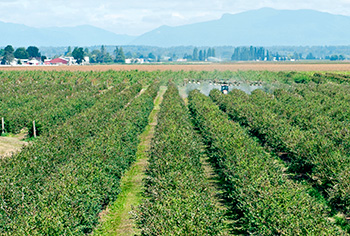OSU Pesticide Expert Explains Ramifications of Megasuit for Oregon Growers
In a sweeping presentation, Oregon State University Specialty Crops Pesticide Registration Research Leader Dani Lightle walked Oregon blueberry growers through some of the ramifications coming out of the EPA’s response to continued litigation over its regulation of pesticides.
 |
Dani Lightle speaks at the Oregon Blueberry Conference. |
In the February 6 presentation at the Oregon Blueberry Conference in Salem, Lightle provided information on EPA’s proposed Vulnerable Species Pilot Project, its draft herbicide strategy, which EPA released last August, and its latest draft rodenticide strategy, which EPA released in November.
Lightle traced EPA’s actions back to litigation that the agency fought for years regarding pesticides’ effects on endangered species, and specifically in regard to compliance issues with the Endangered Species Act. The litigation culminated in what is known as the Megasuit, a lawsuit brought by the Center for Biological Diversity and the Pesticide Action Network that challenged the registered use of 382 active ingredients as harmful to listed species.
That list was trimmed to 35 in a final settlement agreement signed last September. In the settlement, in exchange for not cancelling the uses of the 35 active ingredients, EPA agreed to implement mitigation measures on the pesticides’ uses. In addition, EPA is planning to implement the mitigation measures when registering all new active ingredients and those active ingredients up for review.
“EPA is required by Congress to review every active ingredient every fifteen years, so as they come up for review, they are going to go through the endangered species assessment, and mitigations are going to be added to labels,” Lightle said.
Eventually, she said, all conventional pesticides, as well as antimicrobials and biopesticides, are going to go through risk analysis and label mitigations to ensure that listed species are not being harmed.
In its first plan, the Vulnerable Species Pilot Project, which EPA released early last summer, the agency designated pesticide use limitation areas, or PULAs, for 27 vulnerable species. In Oregon, the EPA’s draft project initially eliminated pesticide use on 700,000 acres of productive agriculture and forestry land for the protection of the Taylor’s checkerspot butterfly.
The proposal was roundly criticized, given that the butterfly’s known area of habitat in Oregon is less than 20 acres in the Corvallis area, and not on any ag land.
After receiving well over 12,000 comments, the EPA walked back the proposal. “With their plan update in November, they said that they were going to get rid of the avoidance zones for ag uses,” Lightle said. “Weirdly, they did not say that for forestry uses, so keep your forestry friends in mind. But at least ag is off the hook here and EPA is saying that they don’t feel like there’s a need for that because of the other mitigations that we can put into place on agricultural uses. So, at least for the Vulnerable Species Pilot Project, we don’t need to worry about the avoidance zones going into place right now.”
She added that the EPA plans to make the PULAs more representative of where the species is found, which in the case of the butterfly is the 12 to 20 acres of land just outside of Corvallis. Also, she said, the EPA plans to have a new plan for the Vulnerable Species Pilot Project in September of 2024.
“So, it’s not the last you’ve heard of it,” Lightle said. “Hopefully this next version will be a little less scary.”
Next, Lightle talked about EPA’s proposed herbicide strategy.
 |
Under its current proposal, EPA will mitigate herbicide use based in part on the risk it carries for listed species, a risk that will be affected mainly by the potential for offsite movement of the chemistry being applied. EPA will measure risks on a point basis, with the higher the point assigned to an active ingredient, the higher the risk.
Applicators who want to apply a high-risk herbicide, under the proposal, would be assigned more mitigation measures than those applying a low-risk herbicide before a herbicide could be used. Mitigation measures could include reduced rates of usage, implementation of buffer strips or reduced tillage, cover cropping or other measures to reduce the chance of runoff.
EPA has said it plans to release its final plan about May 24, Lightle said, and that it plans to implement the plan through the use of a system known as Bulletins Live! Two, or BLT, which EPA will roll out for each herbicide as it is registered or reviewed.
In BLT, an applicator must check for restrictions on his or her planned application no more than six months prior to an application up to the day of an application by going to a website, selecting the month of application, adding the registration number of the material he or she plans to apply and clicking on the site of application on a map provided by EPA. The website will then provide the applicator with any required mitigation measures.
Lightle also provided attendees information on EPA’s proposed rodenticide strategy, particularly as it pertains to use of zinc phosphide. Included in proposed mitigation measures for the vole control material, one stands out as particularly problematic, Lightle said, that being that applicators will need to conduct a carcass search and dispose of all carcasses starting four days after the first application and at subsequent intervals of one to two days for at least two weeks after the last application, or longer if carcasses are still being found.
The proposed mitigation measure has questionable merits, Lightle said. “It is pretty inefficient in that most of our rodents die underground. When they are not feeling good, they’re not going to go out for a walk. They’re going to sit at home and be miserable like we do when we’re sick.”
Also, she said zinc phosphide is known to dissipate relatively quickly when ingested, so the risk of zinc phosphide poisoning to secondary consumer is very low. Still, she said, “Unfortunately, this is what EPA is proposing.”